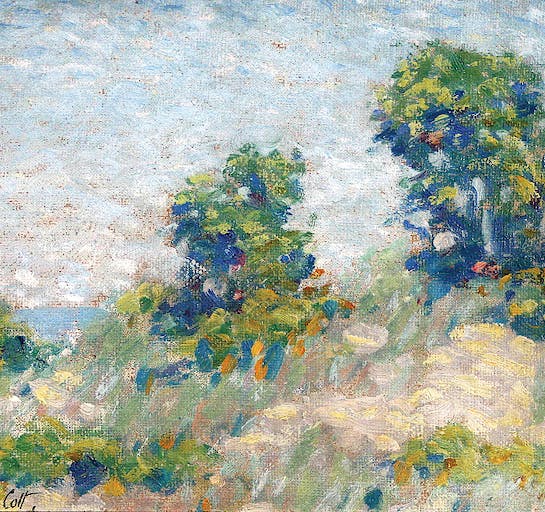Morgan Colt
1876 - 1926

Morgan Colt
1876 - 1926
art of the Pennsylvania School, impressionists who painted in Bucks County, Pennsylvania and who were regarded as the leading landscape school in the early part of the 20th century, Morgan Colt had joined the group in 1912. Along with Edward Redfield, Daniel Garber, Robert Spencer, Charles Rosen, William Lathrop and Rae Sloan Bredin, they eschewed modernism and exhibited together, calling themselves the New Hope Group.
Colt was better known for crafts than for painting, but he did exhibit paintings with the New Hope Group in 1916 and 1917 at the Cincinnati Art Museum, Detroit Art Institute, Corcoran Gallery, the Carnegie Institute and the Arlington Gallery in New York City. By 1929, many of these artists plus others exhibited together, calling themselves the New Hope Art Colony, but Colt died before their first exhibition, which was in May 1929.
Colt's background was architecture, which he had studied at Columbia University. Of him it was said that among the Pennsylvania School, he made more of a contribution as a craftsman than as a painter. He was born in Summit, New Jersey in 1876. In 1912, he built a houseboat, the Deewaydin, which he originally intended for him and his wife to inhabit on the Delaware Canal at New Hope, but they found it unmanageable. They lived in a house and later purchased the studio of William Lathrop, which Colt transformed it into a distinguished Tudor residence. In 1919, he added more buildings and the establishment became known as the Gothic Shops. There he exhibited furniture and metalwork, something for which he was particularly noted and for which he is associated with the Arts and Crafts Movement in America in the late 19th and early 20th centuries. His specialty was metal garden furniture and fire screens with emphasis on hand-wrought iron.
Because Colt was more of a craftsman than a painter, he has not received much attention in the art books. One of the best sources of information about his work is an article by Jesse Martin Breese, published in Country Life Magazine, February 1926, and titled "Morgan Colt: Craftsman Extraordinary". However, he did paintings that got positive attention including Canal Boat, ca 1915-1925. Depicting a barge man navigating his boat on the Delaware Canal, it is described as "the most impressive work by this artist that has come to light. This is the only work known by the artist to display a substantial use of flecked and broken brushwork, typical of Impressionism." (Folk 96)
After Colt's death in 1926, the new owner of the Colt property destroyed many of his paintings, thinking them without value. It is difficult many years later to assess them or to know the breadth of his subject matter.
